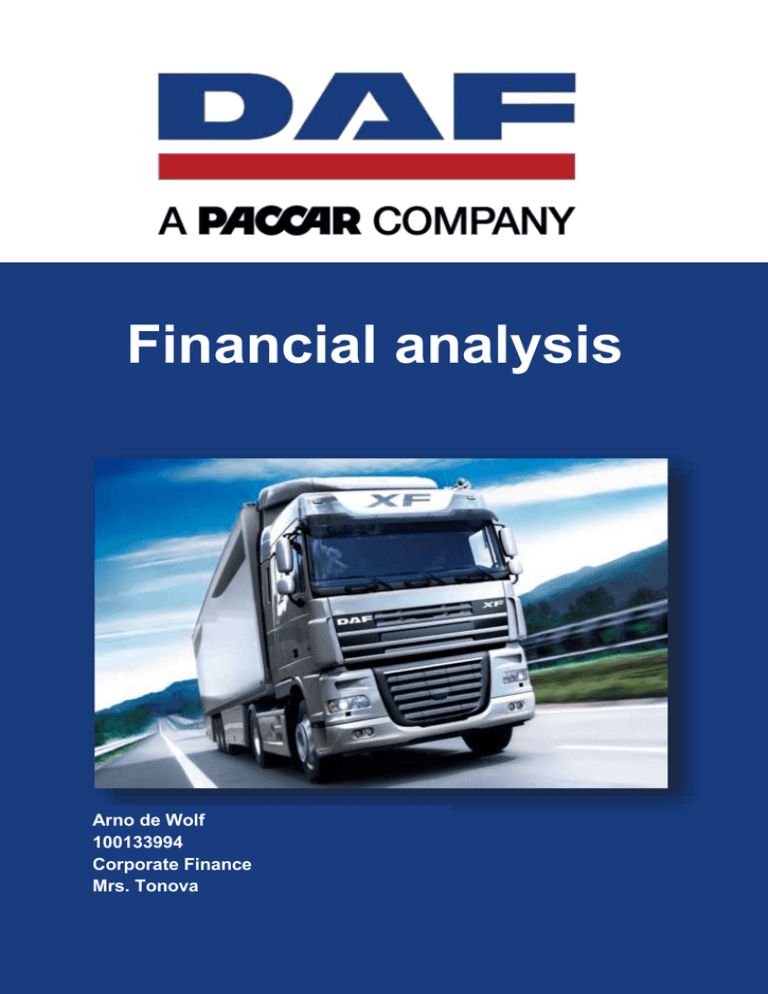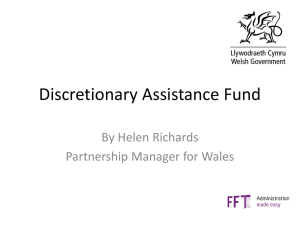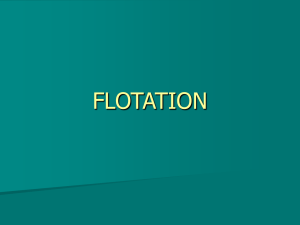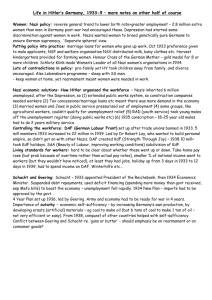Finance assignment
advertisement

Financial analysis Arno de Wolf 100133994 Corporate Finance Mrs. Tonova Executive Summary DAF is a Dutch truck producer that sells its trucks all over the world. DAF was founded in 1932 by two brothers, Hub and Wim van Doorne. Nowadays, DAF is a division of PACCAR and has a worldwide network consisting of approximately 1,000 dealers and service points in inter alia, Europe, Africa, Australia and Taiwan with its headquarters located in Eindhoven, the Netherlands. In the European market, DAF had a market share of 15.5% in the 16+ tons segment in 2011. In facts, this comes down to 241,000 registered trucks in this segment. In addition to their trucks, DAF also sells DAF genuine parts, DAF accessories and TRP parts. Because DAF is a part of PACCAR Company the stock price is based on the stock price of PACCAR which lies at $63.79 as per the last attained data at the 25th of Februari. This is a decrease from the last closing price with 0.19%. This paper tries to make a detailed analysis of financial statements and key ratios to make predictions about the financial health of DAF/PACCAR and the returns on investing in it. When looking at the statement of Profit and loss, the investor will see a small decrease in turnover and net profit which will maybe make him a bit uncertain about the stability of the corporation. Looking at the gross profit and the net profit margins, it shows that they are very consistent, both recording around the 7 and 13 percent. This isn’t the case with the ROE and ROA, they both experience fairly big decreases so there is a change that investments don’t really get a good return. This is also confirmed by a very high debt ratio of 62.08%, which means that they need many external resources to sell their products. Also this is not a good sign for investors. On the other hand, when looking at the current ratio and quick ratio, it is safe to say that DAF is very well capable of paying its short term debts on a short notice. And comparing it with the competitors and the industry average, it is clear that DAF is doing a good job on this part. One of the things that really points out is the return on inventory, which is way higher than any of the competitors or the industry average. Where the other efficiency ratio, the asset turnover ratio, is also higher than the industry average, but not see extremely much higher as the return on inventory. The only thing that is a bit worrying is the point that both rates are decreasing which means that the company is getting less efficient in using their assets and inventory. Everything in conclusion, the ratios state that DAF is a bit underperforming and if they don’t do anything about it, it could very well be that they will be experiencing financial problems in a couple of years. Still, because it is a daughter corporation from PACCAR, it is save to invest in it because they will never be allowed to keep these kind of performances up. Profitability: how profitable is the company? How many money is made with the assets within the company? Profitability ratios for 2011 Return on Equity Before Taxes Return on Equity After Taxes Cost of Debt Return on Assets Profitability ratios for 2012 Return on Equity Before Taxes Return on Equity After Taxes Cost of Debt Return on Assets Percentage 43.703% 33.622% 0.250% 17.123% Percentage PACCAR's Ratio's Profitability: Return on Assests Profitability: Return on Equity 33.004% 25.546% 0.204% 12.668% 13,8% 7,2% Interpreting the tables above, DAF has a very high return on equity. This means that the company gets a high return on the equities they use generating income. The only problem with this is that the risks are very high. Although DAF still has a high ROE, it decreased with 10% over the last year. Reason for this is the drop in sales between 2011 and 2012 and the increase of reserves in the same period. Hence, DAF sold less trucks and parts with more equity. Still, the ROE is much higher than the ROE of PACCAR. This means that PACCAR needs even more equity to sell their products. DAF also saw a decline in ROA between 2011 and 2012 from 17.1% to 12.7%. That isn’t good news for investors, because every euro invested in DAF, now makes around 5% less profit. Reason for this is again the decrease in sales and the increase in total assets. DAF needed in the course of 2012 more assets to sell less. Compared to PACCAR, DAF would be less interesting to invest in, in 2012. But, that is the risk in investing in a company with a higher ROE. Apart from that, it is easier for PACCAR to get more return on assets because they are the mother company of three other brands including DAF. So when DAF’s ROA decreases, the ROA of PACCAR does not have to decrease too because the two other companies could compensate for it. The parts where DAF is really strong, is the Cost of Debt. Because their net-paid interest is very low, the COD is also very low. This means, when you look at all the three ratios together, that the ROA is much higher than de COD. So euro’s collected from liabilities return 12.7%, where they only cost 0.204%. Hence, 12.5% can be relocated to shareholders plus, they get another 12.7% return on their own invested money. And that is why the ROE is higher than the ROA. TATO 2011 1.628023524 TATO 2012 1.287057302 The asset turnover ratio for DAF is above 1, so DAF is efficiently using its assets. The only problem is that it’s decreasing and they have to watch out that it decreases to less than 1. Compared to the Industry, DAF is still doing a good job, because that number lies at 0.84 1 Inventory turnover 2011 Inventory turnover 2012 33.6041816 27.98778695 Also inventory turnover is decreasing which isn’t a good sign for the company because it means that in the long run the company will have a surplus of inventory. However, the ratio is so high that the company doesn’t have to worry because it’s much higher than the industry average, which is 11.47 2 (last quarter of 2013) 1 2 http://csimarket.com/Industry/industry_Efficiency.php?ind=404 http://csimarket.com/Industry/industry_Efficiency.php?ind=404 Solvability: Is DAF capable of fulfilling their liabilities on the long term? How are the total assets of DAF divided over equity and liabilities? Solvability ratio's for 2011 Debt ratio Total Capital and reserves/Total assets Total C&R/Total liabilities Total assets/Total liabilities Total assets/Total C&R Interest coverage Ratio Cashflow coverage Ratio Ratio Solvability ratio's for 2012 Debt ratio Total Capital and reserves/Total assets Total C&R/Total liabilities Total assets/Total liabilities Total assets/Total C&R Interest coverage Ratio Cashflow coverage Ratio Ratio 61,08% 38,92% 63,71% 163,71% 256,95% 113,53 3,80 € € 62,08% 37,92% 61,07% 161,07% 263,74% 101,77 7,06 € € PACCAR's Ratio's Solvability Total Equity/Total Assets 31,38% When it comes to the solvability ratios, DAF scores quite high on its debt ratio. Hence, from the total assets DAF has, 62.08% is debt. Most things in the company are paid for with borrowed money, or in other words, DAF is dependent on leverage (money borrowed and/or owned by others). But because DAF is a big, well-established company, that doesn’t have any problems generating more return than the cost of capital, this isn’t problem. One of the reasons for this is the very low cost of debt. Because DAF acquisitioned more liabilities than equity between 2011 and 2012, the debt ratio rose with 1%. However, this rate is still lower than the debt ratio of PACCAR, which lies at 68.62%. Still, because of the low interest costs DAF has to pay, its interest coverage ratio is very high. This means that DAF generates more than enough operating profit to cover its interest expenses, so it will always be capable to pay the interest over its debt. One of the possible reasons for the low debt interest is that the only real interest that has to be paid comes from PACCAR and PACCAR doesn’t benefit if DAF can’t pay its debts so they keep the percentages low. Because of this, the cash flow coverage ratio is also way above the norm (which is 1). So DAF is also able to pay interest and amortization costs. One thing that stands out is that the CCR almost doubled between 2011 and 2012. The major cause of this is that DAF paid more 50% less on amortization costs than in 2011, which mainly came from the drop in amortization costs on intangible fixed assets (from 77,383 million to 6,324 million). Liquidity: is DAF capable of paying its short term debt? Liquidity ratio's for 2011 Current Ratio Quick Ratio Net Working Capital Rate of turnover Time of Turnover Ratio 1.56 1.41 € 419,437,000.00 29.19699026 12.50128855 Liquidity ratio's for 2012 Current Ratio Quick Ratio Net Working Capital Rate of turnover Time of turnover PACCAR's Ratio's Liquidity Current Ratio Liquidity Quick Ratio Ratio 1.50 1.34 € 401,886,000.00 25.27282879 14.44238803 1,36 1,29 When looking at the NWC, it is safe to assume that DAF is liquid. Its current assets are way higher than the current liabilities, which makes it possible to pay for them on short term notice. The only problem with this number is that it is an absolute number and not a percentage, so it isn’t possible to say anything useful about it besides that DAF has 400million extra to pay short term debts with. A high NWC could be a bad thing, because it could mean that the company doesn’t invest their excess cash or that they have too much inventory. But with a rate of turnover (Inventory turnover) of 25.27 and a drop in cash and cash equivalents of around the 50%, this isn’t very plausible. To get a better view of the liquidity of DAF, it’s smart to take a look at the current and quick ratio. They give a more clearly sight in the capability of paying for short term debt, because they are ratio’s instead of an absolute number. The current ratio states that DAF is capable of paying its debt with its current assets (1.50 where the norm is 1.5-2). This means that DAF has quite an efficient operating cycle and can fairly easily turn its products into cash. Although it has suffered a little set back in 2012 (from 1.56 to 1.50), which was caused by a greater growth in current liabilities than current assets, the current ratio of DAF still remains better than the one from PACCAR, which is slightly under the norm. At last there is the quick ratio. This ratio gives an even better overview of a company’s capability of paying for its short term debts because it doesn’t take the inventories in to account and thus precisely calculates the amount of cash a company has to pay its debts with, relatively. The norm for this ratio is at least 1, so it is safe to say that both DAF and PACCAR are scoring well on this ratio (€1.34 cash on €1 debt and €1.29 cash on €1 debt). Where PACCAR scored a bit too low on its current ratio, regarding the quick ratio the company is still capable of paying it short term debt. This is possible because PACCAR apparently has a low amount of inventories which drives up the current ratio, and a big amount of cash, marketable securities and receivables to finally pay its debt with. Taking everything into account, it is sure thing that DAF, and also PACCAR, is a very healthy company which scores good on every aspect of the financial analysis. Because of these scores, DAF can easily take some risks when it decides to invest somewhere. It has more than enough financial capability to enter a country and to become a big player in the market there immediately. It should also be easy for DAF to attract new investors because potential shareholders can be content with the high percentage of return on their investments. And although all the ratios suffered a little downfall over 2012, DAF isn’t a company which will be in financial problems any time soon. Sources: http://www.nasdaq.com/symbol/pcar http://www.paccar.com/media/1738/paccar2013ar.pdf http://www.creditguru.com/ratios/inr.htm https://portal.fontys.nl/instituten/feht/imm/Semester%206/General/DAF%20Information/DAF %20NV-AR-%202012.pdf DAF Trucks N.V. Annual report 2011 & 2012



